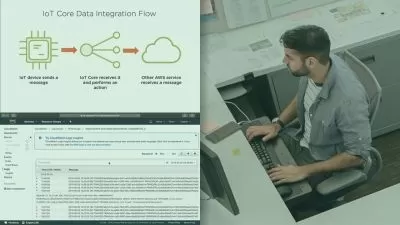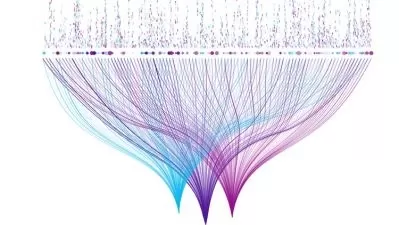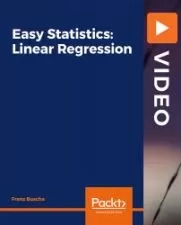Statistical Thinking for Data Analysis
Anthony Donoghue
5:08:42
Description
Truly understand how to interpret and communicate data analysis results by learning how to think statistically
What You'll Learn?
- Learn correct and insightful explanations of statistical concepts from an experienced Columbia professor
- Develop a solid foundation in statistical thinking necessary to become a good data analyst
- Learn how to conduct descriptive and statistical analysis on real-world data using R and RStudio
- Learn how to correctly interpret data visualizations and summary statistics
- Gain a proper understanding of confidence intervals used for making decisions using data
- Truly understand the reasoning of hypothesis testing used for making decisions using data
- Understand the strengths and limitations of hypothesis testing and how it can be misused
- Build and interpret linear regression models with confidence
- Learn statistical concepts through media, research and real-world data examples
Who is this for?
What You Need to Know?
More details
DescriptionCourse Description
Most students go into the working world not really understanding statistics at its foundation. In this course, we will learn how to think like a statistician (as opposed to like a mathematician) about statistical calculations. There is a world of difference. In the workplace, you will "get it" while those around you won't, putting you ahead of the curve.
Learn How to Think Statistically About Data Analysis Results
· Build your knowledge and understanding of statistics on solid foundations
· Learn how to visualize, measure, minimize and reason with variation in data
· Learn how to reason with the variation in sample statistics in order to make good decisions
· Understand the reasoning of hypothesis testing and what a p-value really means
· Understand linear regression and gain the insight “All models are wrong, but some are usefulâ€
· Engrain your understanding through media, research and real-world data examples
Stand Out By Understanding What Your Data Analysis Really Means
Knowing how to interpret and communicate the results of data analysis has become an absolute necessity for employees of numerous types of businesses and organizations working with data. However, many students leave introductory statistics courses (and college) without a solid understanding of what the statistical calculations mean.
This course is for anyone who needs to be able to conduct data analysis and/or interpret the results of data analysis with confidence. The focus is on understanding and reasoning with the statistical calculations and not the calculations themselves. The use of media, research and real-world data examples makes the statistical concepts more engaging, palatable and relevant.
Content Overview
The course contains 42 lectures with 6 hours of content and requires no previous experience in data analysis. You can also gain access to the first chapter of my textbook the course is based upon titled "Statistical Thinking through Media Examples".
Statistical thinking is a necessary foundation for any science that involves the analysis of data. If you work with data in any capacity, you need to have a solid foundation in statistical thinking. Without it, you will always be on shaky ground, not exactly sure what the results of your data analysis actually mean.
Statistical thinking begins with the question about the world of populations. We pursue answers to those questions using sample data and statistics. A sample statistic is an estimate of an unknown truth in a population of interest known as a population parameter.
We will contrast the complexity of data collected from observational studies, where causal conclusions can’t be made due to what are known as confounding factors, with the power of randomized experiments to enable us to make causal conclusions about how the world works. This understanding of the complexity of data, and the questioning of the quality of your data, is a important first step in becoming a good data analyst.
We will learn how to measure the level of uncertainty in our decision making with regard to how the world works using probability. A p-value, the end result of the reasoning of hypothesis testing used for decision making, is a conditional probability. Therefore we will focus primarily on understanding what we mean by conditional probability.
We will learn how to measure and reason with the variation in data through the interpretation of data visualizations and summary statistics. As random as the world of variation appears, order is often found in the variation of measurements, in the shape of the normal (probability) distribution or bell-shaped curve. We will become familiar with the characteristics of this curve and how to use it to calculate the probability of particular events occurring.
This order in randomness (in the shape of the normal distribution) is also to be found in the distribution of sample statistics (known as the sampling distribution), around the population parameter of interest. We will use this foundational framework, along with our sample statistic, to make decisions regarding possible values for the population parameter of interest. A solid foundational understanding of these concepts is an absolute necessity for understanding the reasoning of statistical analysis we cover over much of the remainder of the course.
We will reason with the sampling distribution to try and capture the population parameter of interest within a range of plausible values known as a confidence interval. We will reason with the meaning and interpretation of confidence intervals through media, research and real-world data examples.
We will reason with the sampling distribution to learn a very powerful, but often misunderstood process of reasoning for making decisions about the value of population parameters known as hypothesis testing. We will reason with what a p-value and statistical significance really mean, plus gain a solid understanding of very important concepts like the power of the test. We will engrain our understanding of hypothesis testing through media, research and real-world data examples.
We will learn a very powerful and versatile statistical technique known as linear regression, much used in both the field of statistics and data science, for building statistical models that approximate the complex relationships between variables in the observational world of data. Once you gain the insight that “All models are wrong, but some are usefulâ€, you will have succeeded in this course and are truly a statistical thinker.
Finally, we will look at how the process of hypothesis testing can be misused (or simply misunderstood) by researchers due to a lack of a solid foundation in statistical thinking.
The course is based on the third edition of my textbook titled “Statistical Thinking through Media Examples†published by Cognella Inc. It works very well as an armchair study as you work through the course lectures. It was written as a clear and concise narrative with numerous media, research and real-world data examples. This approach makes the statistical concepts more engaging, palatable and relevant to the world around you.
Chapter 2 and chapter 3 of the textbook are not covered in this course. In these chapters we learn how to critically access the quality of research including polls and surveys. We go beyond the news headlines to the source of the research to question the quality of the study design and data collected. No matter how solid a foundation you have in statistical thinking, the bedrock of data analysis is data, so it is very important to have an understanding of the quality of the data you are working with.
It is not necessary to purchase the book in order to succeed in this course. However, it provides strong support as you work through the lectures and a more complete learning experience with many more media, research and real-world data examples.
Who this course is for:
- Professionals, like journalists and medical practitioners, who need to be able to read and assess the quality of research findings presented in journal articles
- Professionals working with data who need to conduct, interpret and communicate of the results of data analysis
- Managers and executives who need to be able to read and understand data analysis reports
- Students taking an introductory course in statistics who want to gain a proper understanding of the statistical concepts
- Students who have taken more advanced statistics courses who want a more solid foundational understanding of hypothesis testing, confidence intervals and linear regression
- Anyone who wants to develop their statistical thinking skills to better question statistical information presented in the media
Course Description
Most students go into the working world not really understanding statistics at its foundation. In this course, we will learn how to think like a statistician (as opposed to like a mathematician) about statistical calculations. There is a world of difference. In the workplace, you will "get it" while those around you won't, putting you ahead of the curve.
Learn How to Think Statistically About Data Analysis Results
· Build your knowledge and understanding of statistics on solid foundations
· Learn how to visualize, measure, minimize and reason with variation in data
· Learn how to reason with the variation in sample statistics in order to make good decisions
· Understand the reasoning of hypothesis testing and what a p-value really means
· Understand linear regression and gain the insight “All models are wrong, but some are usefulâ€
· Engrain your understanding through media, research and real-world data examples
Stand Out By Understanding What Your Data Analysis Really Means
Knowing how to interpret and communicate the results of data analysis has become an absolute necessity for employees of numerous types of businesses and organizations working with data. However, many students leave introductory statistics courses (and college) without a solid understanding of what the statistical calculations mean.
This course is for anyone who needs to be able to conduct data analysis and/or interpret the results of data analysis with confidence. The focus is on understanding and reasoning with the statistical calculations and not the calculations themselves. The use of media, research and real-world data examples makes the statistical concepts more engaging, palatable and relevant.
Content Overview
The course contains 42 lectures with 6 hours of content and requires no previous experience in data analysis. You can also gain access to the first chapter of my textbook the course is based upon titled "Statistical Thinking through Media Examples".
Statistical thinking is a necessary foundation for any science that involves the analysis of data. If you work with data in any capacity, you need to have a solid foundation in statistical thinking. Without it, you will always be on shaky ground, not exactly sure what the results of your data analysis actually mean.
Statistical thinking begins with the question about the world of populations. We pursue answers to those questions using sample data and statistics. A sample statistic is an estimate of an unknown truth in a population of interest known as a population parameter.
We will contrast the complexity of data collected from observational studies, where causal conclusions can’t be made due to what are known as confounding factors, with the power of randomized experiments to enable us to make causal conclusions about how the world works. This understanding of the complexity of data, and the questioning of the quality of your data, is a important first step in becoming a good data analyst.
We will learn how to measure the level of uncertainty in our decision making with regard to how the world works using probability. A p-value, the end result of the reasoning of hypothesis testing used for decision making, is a conditional probability. Therefore we will focus primarily on understanding what we mean by conditional probability.
We will learn how to measure and reason with the variation in data through the interpretation of data visualizations and summary statistics. As random as the world of variation appears, order is often found in the variation of measurements, in the shape of the normal (probability) distribution or bell-shaped curve. We will become familiar with the characteristics of this curve and how to use it to calculate the probability of particular events occurring.
This order in randomness (in the shape of the normal distribution) is also to be found in the distribution of sample statistics (known as the sampling distribution), around the population parameter of interest. We will use this foundational framework, along with our sample statistic, to make decisions regarding possible values for the population parameter of interest. A solid foundational understanding of these concepts is an absolute necessity for understanding the reasoning of statistical analysis we cover over much of the remainder of the course.
We will reason with the sampling distribution to try and capture the population parameter of interest within a range of plausible values known as a confidence interval. We will reason with the meaning and interpretation of confidence intervals through media, research and real-world data examples.
We will reason with the sampling distribution to learn a very powerful, but often misunderstood process of reasoning for making decisions about the value of population parameters known as hypothesis testing. We will reason with what a p-value and statistical significance really mean, plus gain a solid understanding of very important concepts like the power of the test. We will engrain our understanding of hypothesis testing through media, research and real-world data examples.
We will learn a very powerful and versatile statistical technique known as linear regression, much used in both the field of statistics and data science, for building statistical models that approximate the complex relationships between variables in the observational world of data. Once you gain the insight that “All models are wrong, but some are usefulâ€, you will have succeeded in this course and are truly a statistical thinker.
Finally, we will look at how the process of hypothesis testing can be misused (or simply misunderstood) by researchers due to a lack of a solid foundation in statistical thinking.
The course is based on the third edition of my textbook titled “Statistical Thinking through Media Examples†published by Cognella Inc. It works very well as an armchair study as you work through the course lectures. It was written as a clear and concise narrative with numerous media, research and real-world data examples. This approach makes the statistical concepts more engaging, palatable and relevant to the world around you.
Chapter 2 and chapter 3 of the textbook are not covered in this course. In these chapters we learn how to critically access the quality of research including polls and surveys. We go beyond the news headlines to the source of the research to question the quality of the study design and data collected. No matter how solid a foundation you have in statistical thinking, the bedrock of data analysis is data, so it is very important to have an understanding of the quality of the data you are working with.
It is not necessary to purchase the book in order to succeed in this course. However, it provides strong support as you work through the lectures and a more complete learning experience with many more media, research and real-world data examples.
Who this course is for:
- Professionals, like journalists and medical practitioners, who need to be able to read and assess the quality of research findings presented in journal articles
- Professionals working with data who need to conduct, interpret and communicate of the results of data analysis
- Managers and executives who need to be able to read and understand data analysis reports
- Students taking an introductory course in statistics who want to gain a proper understanding of the statistical concepts
- Students who have taken more advanced statistics courses who want a more solid foundational understanding of hypothesis testing, confidence intervals and linear regression
- Anyone who wants to develop their statistical thinking skills to better question statistical information presented in the media
User Reviews
Rating
Anthony Donoghue
Instructor's Courses
Udemy
View courses Udemy- language english
- Training sessions 36
- duration 5:08:42
- Release Date 2023/06/13

















